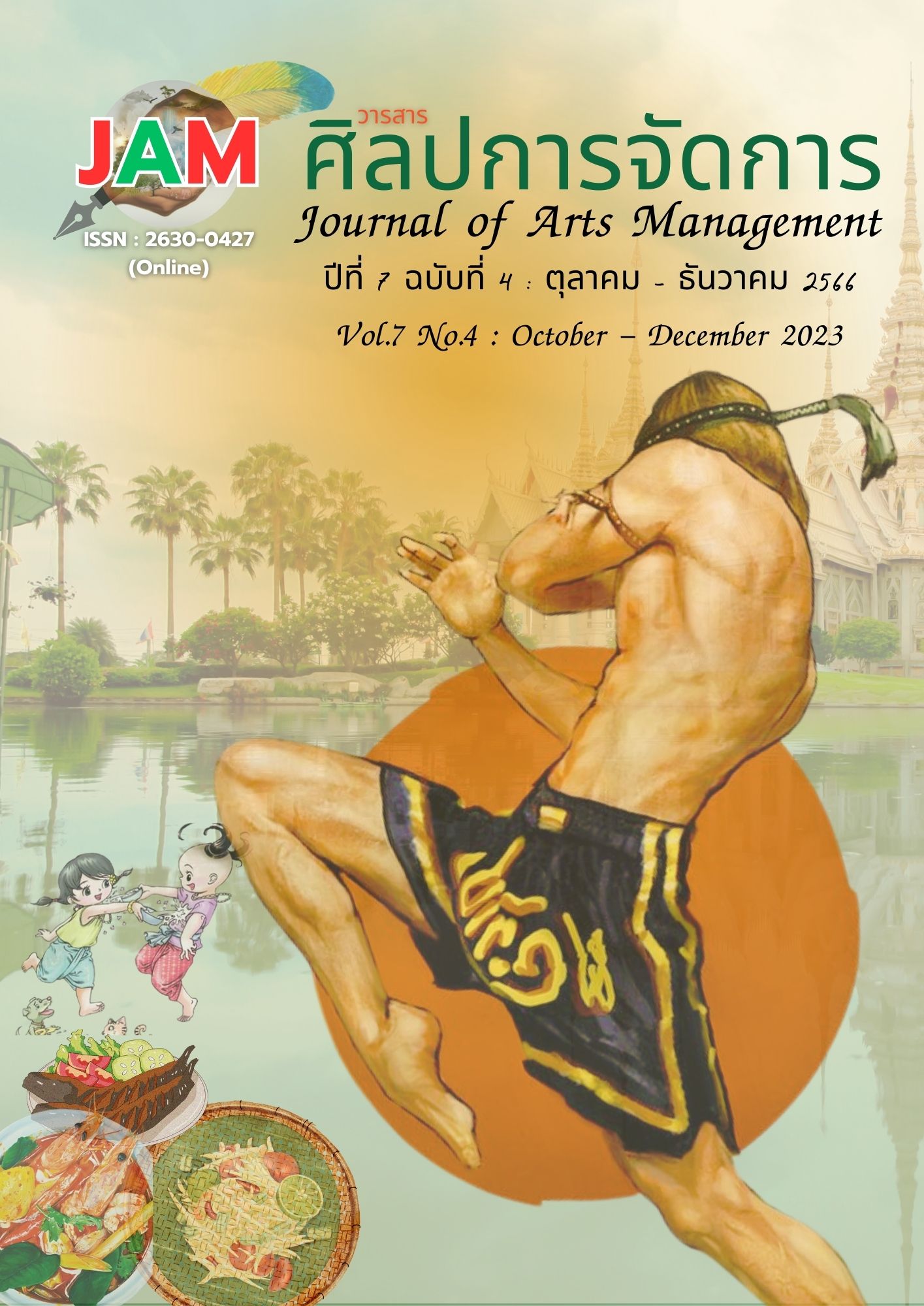การพัฒนารูปแบบการจัดการเรียนการสอนออนไลน์ ร่วมกับกระบวนการทางวิศวกรรม เพื่อส่งเสริมทักษะการคิดเชิงคำนวณ สำหรับนักเรียนชั้นมัธยมศึกษาตอนปลาย
Main Article Content
บทคัดย่อ
บทความนี้มีวัตถุประสงค์เพื่อ 1) ศึกษาปัจจัยด้านการจัดการเรียนการสอนออนไลน์ ของนักเรียนในช่วงสถานการณ์โควิด -19 ที่ผ่านมา สำหรับนักเรียนชั้นมัธยมศึกษาตอนปลาย 2) พัฒนารูปแบบการจัดการเรียนการสอนออนไลน์ ร่วมกับกระบวนการทางวิศวกรรม เพื่อส่งเสริมทักษะการคิดเชิงคำนวณ สำหรับนักเรียนชั้นมัธยมศึกษาตอนปลาย และ 3) ศึกษาผลการจัดการเรียนการสอนออนไลน์ ร่วมกับกระบวนการทางวิศวกรรม เพื่อส่งเสริมทักษะการคิดเชิงคำนวณ สำหรับนักเรียนชั้นมัธยมศึกษาตอนปลาย การวิจัยนี้เป็นการวิจัยและพัฒนา วิเคราะห์ข้อมูลด้วยสถิติเชิงบรรยาย ได้แก่ ค่าเฉลี่ย ค่าร้อยละ ค่าความแปรปรวน และการเปรียบเทียบค่าเฉลี่ยของกลุ่มสองกลุ่ม ผลการวิจัยพบว่า 1) ปัจจัยด้านการจัดการเรียนการสอนออนไลน์ มากที่สุด ได้แก่ ด้านผู้สอน (Mean = 3.75, S.D. = 0.92) ด้านสื่อการเรียนการสอน (Mean = 3.68, S.D. = 0.91) และ ด้านการวัดและประเมินผล (Mean = 3.60, S.D. = 0.92) 2) รูปแบบการจัดการเรียนการสอนออนไลน์ฯ มี 4 องค์ประกอบ ได้แก่ (1) ผู้สอนและผู้เรียน (2) เนื้อหาบทเรียนและกิจกรรมการเรียนการสอน (3) สื่อสนับสนุนการเรียนรู้แบบออนไลน์ (4) การวัดและประเมินผลการจัดการเรียนการสอน โดยรูปแบบดังกล่าวได้รับความคิดเห็นจากผู้ทรงคุณวุฒิ จำนวน 5 ท่าน และ 3) ผลการทดสอบรูปแบบการจัดการเรียนการสอนออนไลน์ ร่วมกับกระบวนการทางวิศวกรรม เพื่อส่งเสริมทักษะการคิดเชิงคำนวณ พบว่า ทักษะการคิดเชิงคำนวณของกลุ่มทดลอง หลังเรียน (Mean = 29.07,S.D.=1.80) สูงกว่าก่อนเรียน (Mean = 14.56 S.D.=3.52)
แตกต่างกันอย่างมีนัยสำคัญที่สถิติที่ .05
Article Details

This work is licensed under a Creative Commons Attribution-NonCommercial-NoDerivatives 4.0 International License.
ทัศนะและความคิดเห็นที่ปรากฏในบทความในวารสารศิลปการจัดการ ถือเป็นความรับผิดชอบของผู้เขียนบทความนั้น และไม่ถือเป็นทัศนะและความรับผิดชอบของกองบรรณาธิการ ยินยอมว่าบทความเป็นลิขสิทธิ์ของวารสารศิลปการจัดการ
References
Bellanca, J., Brandt, R., Wongkijrug, V., & Jittrarot, A. (2019). 21st Century Skills: Rethinking How Students Learn (3rd ed.). Bookcap.
Department of Medical Services, Ministry of Public Health. (2021). Risk Management Manual in Hospitals during the Outbreak of Novel/Recurrent Respiratory Diseases, 2021. Charoensarnwitthayakarn Publishing Company Limited.
Eisner, E. W. (1976). Education Connoisseurship and Criticism: Their Form and Functions in Educational Evaluation, Journal of Aesthetic Education, 10(3/4), 135-150. https://doi.org/10.2307/3332067
Hathayamattayak, M. (2022). Characteristics of School Teacher in Digital Transformation Scenarios. Journal of Bovorn Multi-Education and Human Social Sciences, 2(2), 18-24. https://so03.tci-thaijo.org/index.php/JOB_EHS/article/view/258865
Hutamarn, S., Chookaew, S., Wongwatkit, C., Howimanporn, S., Tonggeod, T., & Panjan, S. (2017). A STEM Robotics Workshop to Promote Computational Thinking Process of Pre-Engineering Students in Thailand: STEMRobot. https://www.researchgate.net/publication/322077301_A_STEM_Robotics_Workshop_to_Promote_Computational_Thinking_Process_of_Pre-_Engineering_Students_in_Thailand_STEMRobot
Kaniemee, S. (2017). Using Engineering Design Processes to Foster Creativity and Problem-Solving Skills[Master's Thesis, Mahasarakham University].
Khan, B. H. (2017). E-Learning Design: Evaluation Checklist. NEO-POINT (1995).
Kuttanan, K., Thippayanuruksakul, K., Chanthawat, T., Sitti, T., Wanaphiphatphong, P., Lonan, W., Kaewurai, R., & Meesuwan, W. (2023). Thai Teachers and Readiness for Online Teaching. T-VET Journal, 7(13), 18-36. https://so01.tci-thaijo.org/index.php/TVETJournal_IVEN3
/article/view/251396
Liaw, S. (2007). Computers and the Internet as a Job-Assisted Tool: Based on the Three-Tier Use Model Approach. Computers in Human Behavior, 23(1), 399-414. https://doi.org/10.1016/j.chb.2004.10.018
Ng, D.T.K., Reynolds, R., Chan, H.M.Y., Li X.H., & Chu, S.K.W. (2020). Business (Teaching) as Usual Amid the Covid-19 Pandemic: A Case Study of Online Teaching Practice in Hong Kong. Journal of Information Technology Education: Research, 19, 777-802. https://doi.org/10.28945/4620
Nkoala, S., & Matsilele, T. (2023). The Influence of The Digital Divide on Emergency Remote Student-Centered Learning During The COVID-19 Pandemic: A Case Study of Journalism Education. SN Social Sciences, 3(3), 47. https://doi.org/10.1007/s43545-023-00626-6
Office of the Basic Education Commission. (2017). Indicators and Core Learning Content: Science Learning Area (Revised Edition 2017) following the Fundamental Education Core Curriculum, B.E. 2551. Office of the Basic Education Commission.
Office of the Secretary-General of the Education Council. (2017). National Education Plan (B.E. 2560-2579). http://www.onec.go.th/index.php/page/view/Outstand/2532
Rim, H. (2015). A Study on Teaching using Website 'Code.org' in Programming Education based on Computational Thinking. Journal of Korea Multimedia Society, 20(2). 382-395. http://koreascience.or.kr/article/JAKO201712835100539.page
Rodriguez, B. R. (2015). Assessing Computational Thinking in Computer Science Unplugged Activities [Master's Thesis, Colorado School of Mines]. https://repository.mines.edu/handle/11124/169998
Srisa-ard, B. (2013). Statistical Methods for Research (5th ed.). Suwiriyasan.
Stephenson, J. E., Tempest, H. G., Griffin, D. K., Mileham, A., & Payne, A. M. (2007). The Use of An E-Learning Constructivist Solution in Workplace Learning. In ECCE '07: Proceedings of The 14th European Conference on Cognitive Ergonomics: Invent! Explore!, 133-138. https://doi.org/10.1145/1362550.1362577
Syukri, M., Soewarno, S., Halim, L., & Mohtar, L. E. (2018). The Impact of Engineering Design Process in Teaching and Learning to Enhance Students’ Science Problem-Solving Skills. Journal Pendidikan IPA Indonesia, 7(1), 66-75. https://journal.unnes.ac.id/nju/index.php/jpii/article/view/12297
Wing, J. M. (2006). Computational Thinking. Communications of the ACM, 49(3), 33-35. https://cacm.acm.org/magazines/2006/3/5977-computational-thinking/abstract#

